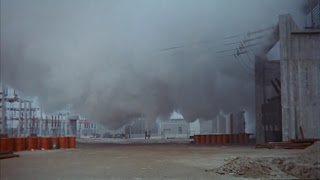Well it seems only right that after a posting on Ingmar Bergman I now do one on Michelangelo Antonioni, who also died this week. I’ve mentioned here before Antonioni’s use of a rocky island landscape in L’avenntura – a rather different kind of island to the ones in Bergman’s films, but no less important to the film. When I saw L’avenntura it was in a double bill with Red Desert – a film as memorable for its strange colours and industrial landscapes as for its disturbing portrayal of mental illness (through Monica Vitti’s character Giuliana). As Michael Gandy says in an essay ‘Landscapes of deliquescence in Michelangelo Antonioni’s Red Desert’, the modern landscape in this film becomes ‘a source of profound mental anguish as if every feature has become transmuted into a threatening presence within Giuliana’s fragile psyche.’
Michael Gandy quotes a 1964 Sight and Sound article in which Michele Manceaux describes Antonioni’s choice of Ravenna ‘for its smoky factories, its oil derricks, its steel pylons. After the war, the pinewoods stretched down to the sea and the town had thirty thousand inhabitants. Today the silos and oil refineries have killed off the trees. Oil has been found here, artificial islands have been built; and there are a hundred and forty thousand inhabitants.’ Manceaux interviewed Antonioni, who said ‘I don’t say that there ought to be a return to nature, that industrialization is wrong. I even find something very beautiful in this mastery of man over matter. To me, these pipes and girders seem just as moving as the trees. Of course it’s horrifying to think that birds which fly through these fumes are going to fall dead, that the gas makes it impossible to grow anything for miles around. But every age, after all, has called for its sacrifices, and it’s out of these that something else has grown.’
Michael Gandy quotes a 1964 Sight and Sound article in which Michele Manceaux describes Antonioni’s choice of Ravenna ‘for its smoky factories, its oil derricks, its steel pylons. After the war, the pinewoods stretched down to the sea and the town had thirty thousand inhabitants. Today the silos and oil refineries have killed off the trees. Oil has been found here, artificial islands have been built; and there are a hundred and forty thousand inhabitants.’ Manceaux interviewed Antonioni, who said ‘I don’t say that there ought to be a return to nature, that industrialization is wrong. I even find something very beautiful in this mastery of man over matter. To me, these pipes and girders seem just as moving as the trees. Of course it’s horrifying to think that birds which fly through these fumes are going to fall dead, that the gas makes it impossible to grow anything for miles around. But every age, after all, has called for its sacrifices, and it’s out of these that something else has grown.’
Gandy situates Red Desert within a history of Italian cinema’s engagement with landscape. This began with an interest in the ‘authentic’ Italian landscape during the fascist period. ‘The development of neo-realism in the 1940s ... marked a political reappropriation of the cultural depiction of landscape that displaced the nationalist sentiments of the fascist era with a neo-Marxian emphasis on landscape as a focus of social and political struggle... Yet, in the cinema of Antonioni, the depiction of landscape moves beyond the physicality of space as a locus for action towards an engagement with the aesthetic effects of landscape on the psychological state of his protagonists. The cinematic landscape becomes the dramatic setting for an exploration of the experience of modernity.’
Red Desert is an interesting film but I’d agree with Gary Morris that there are downsides: ‘the pacing is indeed murderous, with scenes allowed to linger past their dramatic point (which no doubt is the point). For some, Giuliana’s constant state of existential despair and wild ramblings will grate rather than elicit sympathy. There’s a diverting "orgy sequence," but only Antonioni could shoot an orgy in which nobody has sex.’ Red Desert is not a film I want to go back and re-watch, unlike Antonioni’s next film, Blow-Up (1966), which has so many great scenes. In Iain Sinclair's Lights Out for the Territory he describes visiting Maryon Park, location for the possible murder in Blow-Up. The park ‘plays directly into the film, into the very specific sound of wind in the trees.’ ‘You can still find the flakes of dark green paint with which the production designer Assheton Gordon "dressed" the wooden fence. He recomposed the setting so that it could look more like itself.’ I don’t think I actually believe you can still find paint (this sounds like the Patrick Heron story about finding traces of Matisse’s paint) but one day I’m sure I’ll make the pilgrimage to Woolwich just to check.

No comments:
Post a Comment